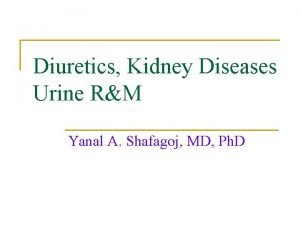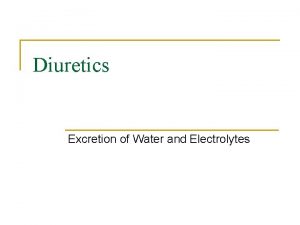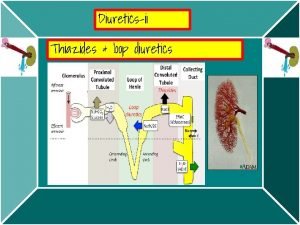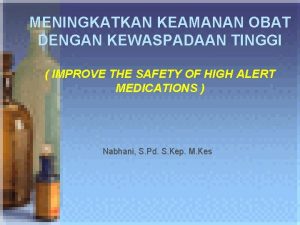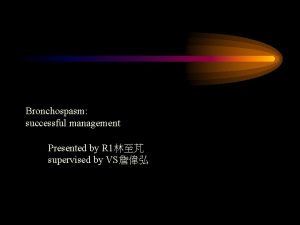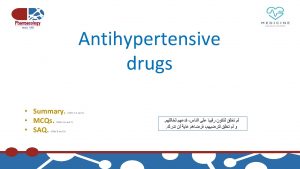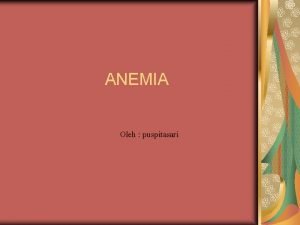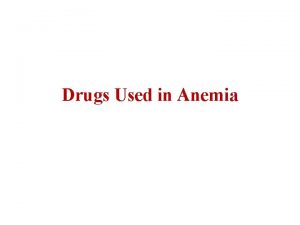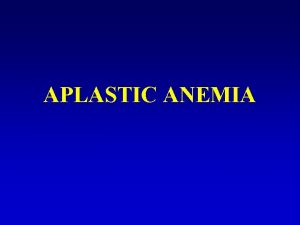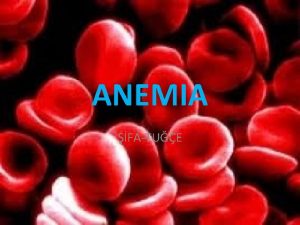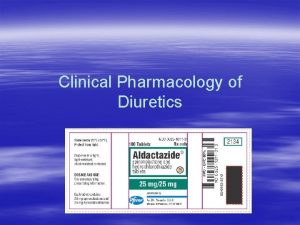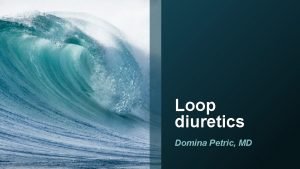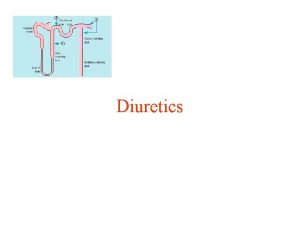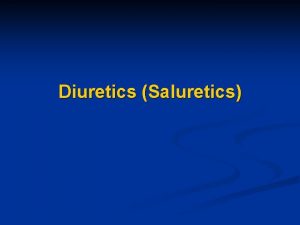Renal Medications Anemia Thiazide and Thiazidelike Diuretics Increases





















- Slides: 21

Renal Medications

Anemia

Thiazide and Thiazide–like Diuretics • Increases sodium and water retention by inhibiting sodium reabsorption in the distal tubule of the kidney • Used for HTN and peripheral edema • Used in patients with normal renal function • Not effective for immediate diuresis • Contraindicated in renal failure • Used with caution when taking digoxin, corticosteroids, or antidiabetic meds

Thiazide and Thiazide–like Diuretics • Side effects – Hypercalcemia – Hyperglycemia – Hyperuricemia – Hypokalemia – Hyponatremia – Hypovolemia – Hypotension • • • Constipation Rashes Photosensitivity Blood dyscrasias Headaches Nausea and vomiting

Thiazide and Thiazide–like Diuretics • Nursing Implementation – Monitor vital signs – Monitor weight – Monitor urine output – Monitor electrolytes – Monitor glucose, calcium, and uric acid – Check peripheral pulses for edema – Instruct to take in the morning to avoid nocturia and sleep interruption

Thiazide and Thiazide–like Diuretics • Nursing Implementation – Instruct to take BP and record – Instruct to eat foods rich in potassium – Instruct to take potassium supplements – Instruct to take med with food to avoid GI upset – Instruct to change position slowly to avoid orthostatic hypotension – Instruct to use sunscreen – Instruct those with DM to have BS checked frequently

Thiazide and Thiazide–like Diuretics • Bendroflumethazide (Naturetin®) Benzthiazide (Exna®) Chlorothiazide (Diuril®) Chlorthalidone (Hygroton®) Hydrochlorothiazide (Hydro. Diuril®) Hydroflumethiazide (Saluron®) Idnapamide (Lozol®) Methyclothiazide (Enduron®) Metolazone (Zaroxylon®) Polythiazide (Renese®) Quinethazone (Hydromox®) Trichloromethiazide (Diurese®)

Loop Diuretics • Inhibit sodium and chloride reabsorption from the loop of Henle and distal tubule • They have little effect on the blood glucose; however they cause marked depletion of water and electrolytes, increased uric acid levels, and the excretion of calcium • Are more potent than thiazide, causing rapid diuresis, thus decreasing vascular fluid volume, cardiac output, and blood pressure • Used for HTN, edema associated with CHF, hypercalcemia, and renal disease • Use with caution when taking digoxin or lithium • Use with caution when taking aminoglycosides, anticoagulants, corticosteroids, or amphotericin B

Loop Diuretics • Side Effects – Hypokalemia – Hyponatremia – Hypocalcemia – Hypomagnesemia – Hypochloremia – Thrombocytopenia – Hyperuricemia – Orthostatic hypotension – Skin disturbances – Ototoxicity and deafness – Thiamine deficiency – dehydration

Loop Diuretics • Nursing Implementation – Monitor vital signs – Monitor weight – Monitor urine output – Monitor electrolytes, calcium, magnesium, and uric acid levels – Check peripheral extremities for edema – Monitor for signs of digitalis toxicity if on this also – Monitor for lithium toxicity if on this also

Loop Diuretics • Nursing Implementation – Instruct to take in the morning – Instruct to monitor own BP and record – Eat foods rich in potassium – Take potassium supplements as prescribed – Take med with food – Change position slowly – ADMINISTER IV FUROSEMIDE (LASIX) SLOWLY BECAUSE HEARING LOSS CAN OCCUR IF INJECTED RAPIDLY

Potassium sparing diuretics • Act on the distal tubule to promote sodium and water excretion and potassium retention • Used for edema and HTN, to increase UO, to treat fluid retention and overload associated with CHF, hepatic cirrhosis or nephrotic syndrome and for diuretic-induced hypokalemia • Contraindicated in severe kidney or hepatic disease or in severe hyperkalemia • Used with caution in the client with diabetes • Used with caution in the client taking antihypertensives or lithium • Used with caution in the patient taking ACE inhibitors because hyperkalemia can result • Used with caution in the patient taking potassium supplements

Potassium sparing diuretics • Side effects – Hyperkalemia – Nausea, vomiting, diarrhea – Rash – Dizziness, weakness – Headache – Dry mouth – Photosensitivity – Anemia – thrombocytopenia

Potassium sparing diuretics • Nursing Implementation – Monitor vital signs – Monitor urine output – Monitor S/S of hyperkalemia • • • Nausea, vomiting diarrhea, Abdominal cramps Tachycardia followed by bradycardia Peaked T waves Oliguria Monitor potassium level Instruct to avoid foods high in potassium Instruct to avoid direct exposure to sun Instruct on S/S of hyperkalemia Instruct to avoid salt substitutes (contain a lot of potassium) Instruct to take with or after meals to decrease GI irritation

Urinary Tract Antiseptics • • Inhibit growth of bacteria in the urine Act as disinfectants within the urinary tract Used to treat urinary tract infections These meds do not achieve effective antibacterial concentrations in blood or tissues and therefore cannot be used for infections outside the urinary tract

Urinary Tract Antiseptics • Nitrofurantoin (Furadantin, Furalan, Macrobid) – an antibiotic, eliminates bacteria that cause urinary tract infections. Antibiotics will not work for colds, flu, or other viral infections. – This medication is sometimes prescribed for other uses – Brown color to urine

Urinary Tract Antiseptics • Side Effects of Nitrofurantoin (Furadantin, Furalan, Macrobid) – difficulty breathing – excessive tiredness – fever or chills – chest pain – persistent cough – numbness, tingling, or pinprick sensation in the fingers and toes – muscle weakness – swelling of the lips or tongue – skin rash

Urinary Tract Antiseptics • Methenamine (Mandelamine, Hipex, Urex) – – – – – Relatively safe and well tolerated May cause gastric distress Chronic high-dose therapy can cause bladder irritation Can cause crystalluria and should no the used in patients with renal impairment Decomposition of med yields ammonia, bad if patient already has liver dysfunction Requires acidic urine with 5. 5 or less Ingestion of large amounts of fluid will reduce antibacterial effects Should not combine with sulfonamides because of the risk of crystalluria and urinary tract injury Patients taking this med should not be given alkalinizing agents

Urinary Tract Antiseptics • Nalidixic acid (Neg. Gram) • Gastrointestinal disturbances: nausea, vomiting and abdominal discomfort • Rash • Visual disturbances • Photosensitivity reactions • May produce intracranial HTN in pediatric patients • After 2 weeks, patient requires blood work-CBC and liver function • Can intensify effects of oral anticoagulants • Contraindicated with history of convulsive disorders

Urinary Tract Antiseptics • Cinaxacin (Cinobac) – Side effects are similar to those of nalidixic acid – Dosage should be reduced in patients with renal impairment; failure to do so will result in accumulation of the med to toxic levels

Urinary Tract Antiseptics • Norfloxacin – Can cause fatigue, headache, nausea, constipation, rash, and elevated liver function tests – Encourage high fluid intake – Advise patient to take medication 1 hour before or 2 hours after meals because food will hamper absorption
 Isothenuria
Isothenuria Mechanism of action of diuretics slideshare
Mechanism of action of diuretics slideshare Ira pré renal renal e pós renal
Ira pré renal renal e pós renal Sindrome nefrótica
Sindrome nefrótica Thiazide
Thiazide Distinguish between renal corpuscle and renal tubule
Distinguish between renal corpuscle and renal tubule Megaloblastic anemia vs pernicious anemia
Megaloblastic anemia vs pernicious anemia Investigation of megaloblastic anemia
Investigation of megaloblastic anemia Causes of megaloblastic anaemia
Causes of megaloblastic anaemia Chapter 11 medications and drugs
Chapter 11 medications and drugs Common pediatric medications
Common pediatric medications Epidural anesthesia medications
Epidural anesthesia medications Hepatitis c medications
Hepatitis c medications List of high-alert medications jci
List of high-alert medications jci Mock code steps
Mock code steps 5 rights of medication
5 rights of medication The term drug basket method is used for dispensing of
The term drug basket method is used for dispensing of Chapter 30 administering medications
Chapter 30 administering medications Medications
Medications Debbie norrie
Debbie norrie Definition of medication reconciliation
Definition of medication reconciliation High risk medications
High risk medications
